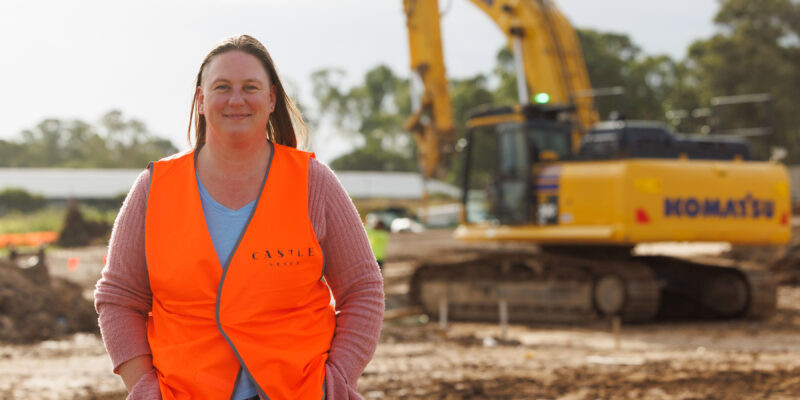Sympli determined to bring the benefits of competition to conveyancing
Interoperability is set to become a reality by the end of 2025 with the promise conveyancers - and their customers - will reap the benefits of greater competition, price, innovation, efficiency and security throughout the settlement process. The CEO of Sympli, Philip Joyce, tells Australian Conveyancer magazine his company is ready to challenge PEXA and become a trusted ELNO, offering choice and convenience to conveyancers, solicitors and lawyers.

AUSTRALIAN Conveyance: You have worked at the ASX as General Manager, NSW Treasury as Transformation Director and Westpac Group as Managing Director Payments. Your experience must place you well for your current role at Sympli?
Philip Joyce: I’ve spent a lot of my career in payments at Westpac, then Treasury and the ASX – that is my subject matter of expertise. And that is part of the conveyancing industry, a really important part. But what I’ve loved about this role is learning the intricacies of a whole new industry. I didn’t realise the importance of house purchases and sales and all the processes that readers of this magazine help Australians with every day. So I bring a bit of experience, but I’m also learning a lot which is fantastic.
AC: Tell us about your role with Sympli, the new ELNO on the block.
PJ: Sympli has been in existence for five years, I came on board three-and-a-half years ago. We’re half owned by the ASX group and half owned by the ATI group. Whilst I was working at the ASX, I was asked would I welcome the opportunity to jump on board at Sympli as the CEO and I was very happy to do so. I’d worked with the Sympli team in my role at ASX so it was a natural kind of evolution from there.
AC: What is your company name Sympli trying to convey?
PJ: One of our values is we’re determined to deliver simplicity to our clients. To take the complexity away from workflow and transactions, make it as easy and intuitive as we can, and let our customers spend their time where they want to, on their customers, not on trying to understand a platform to facilitate settlement.
AC: So there must have been some big investment that’s gone into Sympli?
PJ: We’re fortunate we’ve got two supportive shareholders. The ASX run a lot of settlement businesses in their equity and bond market, in particular. So they bring that expertise, they facilitate our settlement flows. And the ATI group are very big participants in the legal industry, renowned for really meaningful, efficient and great software.
AC: So you’re well placed to know what’s going on in the conveyancing space?
PJ: We get a decent view from where we are placed, particularly of what the future may hold. We’re very privileged we’re connected to a lot of the influencing members of the industry.

AC: What will happen in the future?
PJ: We entered the market to be the second ELNO. Today everyone is effectively (in most states) mandated to use one provider. And so our ‘why’ as an organisation is to bring the benefits of competition to the industry and to our customers. For us what the future really holds is genuine choice for conveyancers, solicitors and law firms to choose the settlement provider they want to. And for that competition to drive all the benefits that you would think of: price, innovation, efficiency, security. So that’s the most exciting part of the future that we believe we can contribute to really strongly.
AC: What are the customer requirements that are going to help Sympli compete with the incumbent, PEXA?
PJ: Whilst the settlement process and the lodgment process – which ELNOs look after – is really important and has to be safe, secure, robust and efficient, it’s one part of a bigger value chain that conveyancers, solicitors and lawyers have to manage across multiple stakeholders.
We are at the very end of the process when a house settles, funds are dispersed, documents are lodged. But there’s a whole bunch of work that happens upstream from that. Our job is to put our proposition in that context, and therefore give the right information at the right time and in the right format to help conveyancers, solicitors and lawyers do their job as easily and as simply (no pun intended!) as possible.
So that’s where we are trying to carve out a point of difference in this market and it’s really what we stand for.
AC: Do you think being the challenger brand is a good position to be in?
PJ: We talk a lot about the promise of the second mover advantage but, at the moment, let’s be frank, it’s very challenging. We are a national provider. We process in every state in Australia, we support three of the major banks and a lot of their processing. So that’s really positive. But the most meaningful part of the market – which is supporting house purchases and sales – we can’t do today.
That’s why interoperability is really important, so we can then support our customers, and they can then support their customers, with the most important transactions that they facilitate today – house purchases and sales. So that’s really where we’re geared towards, how do we offer the best proposition and give time and efficiency and security to our customers?
AC: ARNECC has inked December 2025 as the deadline for interoperability? Is that date what you’re aiming for too?
PJ: All eyes for us are on getting interoperability delivered by December 25. And creating that level playing field where the legal practitioners, conveyancers, solicitors and lawyers have a freedom of choice. That is the only opportunity, I think, for us to enter the market at scale and offer that choice at scale. Because then interoperability is designed so people can subscribe to whichever network they choose and have confidence the transaction will work.
AC: In a nutshell, what does interoperability do?
PJ: It exchanges data between the two networks, and then one of the ELNOs does the final lodgment settlement. We’re not building a rocket ship to Mars, we’re just exchanging information securely between networks. And then one network finalises the lodgment and settlement of that.
But that sharing of information and data is the important point, if we’ve got a practitioner using us and the other participants are on the incumbent, you want to make sure that information is shared so the workspace can lock and then settle appropriately.

AC: What are the challenges of that?
PJ: I’ll speak candidly, the challenges we see are we have most industry participants really supportive of competition. But you’ve got an entrenched incumbent who doesn’t want to do that.
AC: So PEXA is putting up the barriers for you?
PJ: Yeah, they’re putting up barriers. We had the scope of interoperability resolved by ARNECC last year. And we had the incumbents disputing that. Topics such as linked settlement, Linked lodgments and the use of trust accounts which are a huge part of transaction flow today. Without those scope items, of which there are a number, interoperability won’t offer a full and complete service to conveyancers. So it won’t work. It won’t be a level playing field and there won’t be true choice and there won’t be true competition. So that’s one area where we’re seeing big pushback from the incumbent.
AC: PEXA is taking notice of Sympli?
PJ: I think if you’re running the only network and you’ve got all the market and someone is looking to enter that market, I think you would have to take that seriously. I think as more confidence has grown around interoperability…if you go back two years ago, it was just a bullet point on a slide…Now we’ve got legislation, we’ve got regulation, we’ve got dates, it’s happening. As time has gone on, I think that realisation has dawned on them. They’re still fighting on aspects to try and slow it down or reduce its effectiveness. I hope they get to a point where they accept it’s going to happen and then concentrate on giving the best service they can and then let’s let the customer decide.
AC: You have been quite candid about the pushback you’re getting from PEXA. Why?
PJ: Because we will need advocacy from conveyancers, to really champion that they want genuine choice. Because the voice of the end customer is vital in this process. This reform is really about delivering benefits for them. And, in turn, them providing that value to their customers.
The voices of members through their AIC is probably the best channel for that. Advocacy for genuine choice. If they can be vocal around that, be vocal that the timing and the scope is meaningful for them, then I think that will go a long way to getting interoperability done in time, getting it done right. And then they’ll have the benefit of at least two, and then probably more, providers fighting for their business and delivering great features that help them do their job.

AC: ARNECC is behind getting more players into the market?
PJ: Yes, ARNECC has been quite supportive. There’s been a lot of hard work to get us to where we’ve got to, we’d have liked it to be quicker. But the decision has been made on the interoperability model, the dates and the scope. Now, it’s about keeping this reform on track to deliver benefits to the users of the system, which are conveyancers, solicitors, lawyers, banks, and then they flow through to the consumers through lower fees.
If you looked at this nationally, it’s tens of millions of dollars a year of benefit. And that’s without thinking through the even bigger benefits of competition, which are at least two companies competing for business. So having to offer better features, better service, better innovations.
AC: Can you hurry interoperability along?
PJ: We would love to do that. Realistically, the biggest challenge is keeping us on track. The biggest challenge of that is keeping the incumbent honest and getting them to deliver to the timeframes.
AC: What are the key milestones for interoperability?
PJ: There are two key milestones for interoperability. July next year for what we call Release One. That’s the limited refinance offer, supporting only the banks. And then the biggest and most meaningful releases are Two and Three in December of 25.
Release Three is what is important for conveyancers. That’s when there will be competition available to them for transfers, ie supporting house purchases and sales.
Whilst the incumbent has engaged on the plan for July 25, they have yet to commit to December 25. So, if we don’t have a plan for it, or they don’t have a plan for it, how are we going to deliver it? And, importantly, what’s the penalty regime if they (PEXA) don’t meet milestones in advance of that?
So we’re big advocates for more transparent reporting. Getting milestones in place that tell us are we on track to deliver December 25. And then putting enforceable milestones in place that hold both me and my competitor to account.
AC: How will Sympli’s presence in the market affect PEXA?
PJ: We have to earn our customers’ business. We know it’s not just a case of creating the level playing field and all these customers will suddenly walk on over. Our part of the bargain is, we’ve got to have something of value and make sure we deliver those efficiencies. All we’ve ever advocated for is getting a level playing field where customers do have that choice. And then it’s up to us to demonstrate that we have value. So, of course, for the other company, its a downside risk because, when it’s a level playing field, then people will be comparing the offers and then they will have freedom of choice, which they don’t have today.
AC: Do you think there’ll be more than one new ELNO in the market?
PJ: Lextech has been granted their Category One approval. So they’re certainly looking at the market. So that’s good. Interoperability has been designed such that you could accommodate multiple entrants. So that’s also good. I definitely believe a rising tide lifts all boats. So the more innovation, the more thinking, the more competition, I think that just drives us harder.
AC: How will Sympli help conveyancers?
PJ: We want to be measured on how much time and confidence we can give back to a conveyancer so they can get on with doing the other parts of their job and focus on giving great service to their end customer.

AC: Conveyancers are naturally worried about security in interoperability space. What can you say to them about that?
PJ: We take it really seriously because it’s fundamental to us and to our customers’ business. And we know we’ve got to keep evolving, because the threats keep evolving.
My view is interoperability will be better for security for the industry. Because at the moment we’ve got a single point of failure, we’ve got everyone on one network. If that network was to have a problem, there is no opportunity to look to do that anywhere else.
At Sympli we have wholly different connections to land registries, to banks, to revenue offices.
Once interoperability is live, we’re big advocates for looking at how we could build more industry resiliency, such that if we had a problem at a point in time, or a competitor had a problem, we can look at it and how we can facilitate the transactions somewhere else. That isn’t possible today.
I’m also encouraged by a lot of the work in the payment space. The biggest threat, most conveyancers would acknowledge, is the interception of communication and customers paying money to the wrong account. So, there’s a lot of work happening with Australian Payments Plus to improve pay confirmation. The payments code that we’re currently working on across PayNet uplifting the standards that our banks need to operate. So, I actually think competition, again, drives that security impetus. And I can safely say this, I think PEXA and us to be on the same page. We know security is really important so we want to protect end consumers and all the businesses that use our networks.




